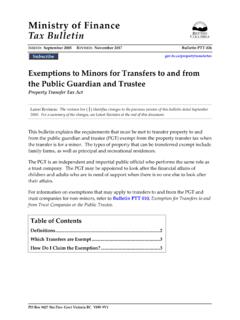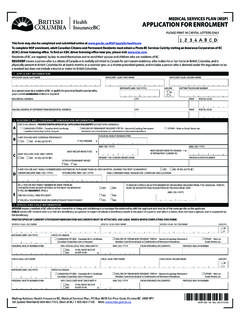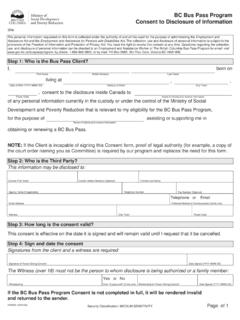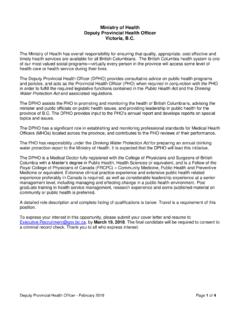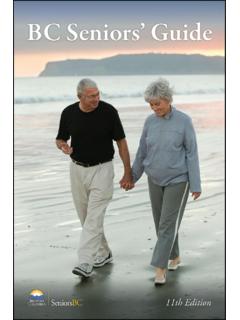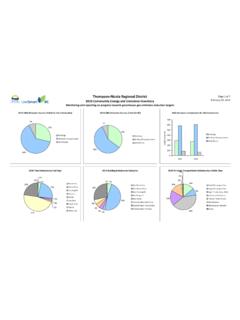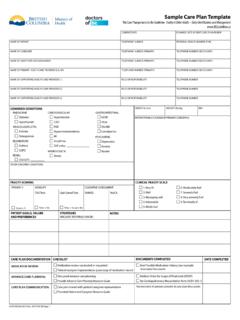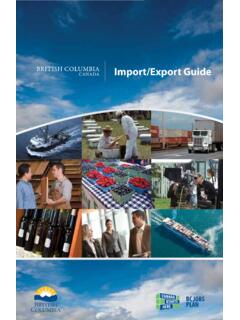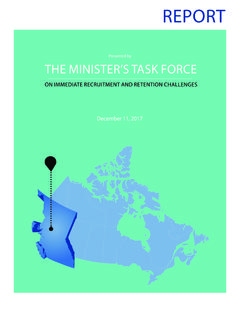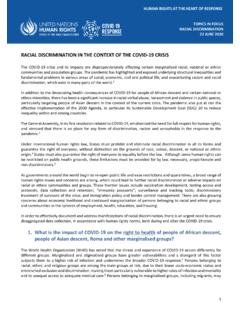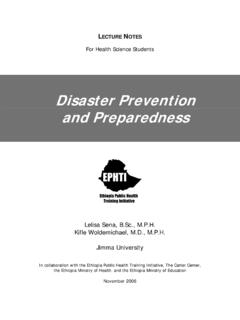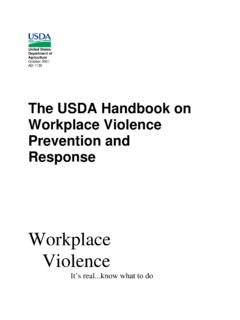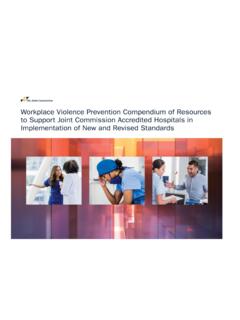Transcription of Workplace Guidelines for the Prevention of Musculoskeletal ...
1 WorkplaceGuidelines for the Prevention of Musculoskeletal injuries A Joint InitiativeA Joint Government and Service Employees UnionPublic Service EmployeeRelations CommissionWorkplaceGuidelines for the Prevention of Musculoskeletal injuries A Joint Initiative2 Workplace Guidelines for the Prevention of Musculoskeletal InjuriesNational Library of Canada Cataloguing in Publication DataMain entry under title: Workplace Guidelines for the Prevention of Musculoskeletal injuries : a joint initiativeISBN 0-7726-4788-71. Musculoskeletal system Wounds and injuries - Prevention . 2. Human engineering. 3. Industrial safety - British Columbia.
2 I. Government and Service Employees Union. II. British Columbia. Public Service Employee Relations 2002 704452 C2002-960116-9 Workplace Guidelines for the Prevention of Musculoskeletal injuries 3 Table of ContentsAcknowledgement .. 6 Introduction .. 7 What is Ergonomics .. 9 Musculoskeletal Injury (MSI) .. 9 Causes of Musculoskeletal Injury (MSI) .. 10 Signs and symptoms of a Musculoskeletal Injury .. 11 Stages of Musculoskeletal injuries .. 12 Health effects can be serious .. 13 Risk Factors that contribute to MSI s .. 15 Primary Risk Factors .. 18 Force .. 18 Work Posture .. 20 Repetition .. 22 Contact Stress.
3 22 Duration and Magnitude .. 23 Secondary Risk Factors .. 25 Environmental Conditions .. 25 Cold Temperatures .. 25 Vibration .. 26 Illumination .. 27 Section OneSection TwoSection Two (B)Section Two (A)4 Workplace Guidelines for the Prevention of Musculoskeletal InjuriesCharacteristics of the organization of work .. 27 Work recovery cycles and task variability .. 27 Work rate .. 29 Other Considerations .. 30 Eliminating or Minimizing Risk Factors .. 31 Engineering controls .. 31 Administrative controls .. 32 Personal Protective Equipment .. 33 Manual Material Handling .. 34 Lifting .. 35 Carrying .. 37 Extended Reaching.
4 40 Working Heights .. 41 Push/Pull .. 43 Workplace Ergonomic Checklist-Introduction .. 46 Workplace Ergonomic Checklist .. 47 Appendix 1 Article Thirteenth Master Agreement between the BC Government and the BCGEU .. 53 Appendix 2 Workers Compensation Board Ergonomics (MSI) Requirements .. 54 Section ThreeSection FourSection FiveAppendices Workplace Guidelines for the Prevention of Musculoskeletal injuries 5 Appendix 3 Sample of Risk Assessment, Ministry of Forest s Ergonomics Investigation Report .. 58 Appendix 4 Sample of Ergonomic Risk Factor Identifi cation recommended by the Workers Compensation Board .. 68 Appendix 5 Sample of Ergonomic Risk Assessment Recommended bythe Workers Compensation Board.
5 73 6 Workplace Guidelines for the Prevention of Musculoskeletal InjuriesAcknowledgementThe authors wish to recognise the following persons for their assistance and contributions to this guide:Joint Provincial Occupational Health and Safety Committee:Debra Barten Rod Mann Mona Sykes Tony RaymondDarryl Walker Bob DalbyMark Christie Wayne IronmongerMohammed Alam Wendy LawrenceGeorge Heyman, President, BC Government and Service Employees UnionDr. William Lakey, Medical Director, Government Employees Health Services and staffBawan Saravanabawan, Ergonomist, Workers Compensation Board of British ColumbiaJoe Paul, Accident and Prevention Section, Ministry of ForestsBC Government Ergonomic Sub-Committee:Laurie Boyle Maggie MontgomeryAngie Chow Joe PaulHeather Caul Jane RutherfordAuthors: Richard Golob, Occupational Health and Safety Advisor,Safety, Workers Compensation & Benefi t Programs,Public Service Employees Relation Commission (PSERC)Mona Sykes Safety Offi cer,British Columbia Government and Service Employees Union (BCGEU)Front cover.
6 Raeside, copied from the previous Ministry of Social Services Joint OSH Committee posterTypesetting and design: Queen s Printer for British Columbia Workplace Guidelines for the Prevention of Musculoskeletal injuries 71. IntroductionThis booklet is a joint venture of the Public Service Employee Relations Commission, the Government of British Columbia, and the BC Government and Service Employees Union. The objective of this booklet is to provide a general guide for Joint Occupational Health and Safety Committee (JOHSC) members, supervisors and workers on how to reduce Musculoskeletal injuries (MSI) in the Workplace . The booklet provides basic information about MSI Prevention and risk factors, and makes available the information a worker should use to actively participate in the Prevention of Workplace Musculoskeletal injuries .
7 Although MSI can happen outside of the Workplace , the focus of this guide is the work areas covered include: What are: MSI s? Risks of MSI? MSI signs and symptoms? Causes of MSI s? Risk factors8 Workplace Guidelines for the Prevention of Musculoskeletal injuries Safe work practices and measures to prevent MSI s. Checklist for JOH&S committee Workplace inspection teams. Examples of ergonomic risk assessments. *Note: For specifi c information on Prevention of MSI in the offi ce environment, refer to the joint booklet Prevention of Strain injuries in the Offi ce Environment . Workplace Guidelines for the Prevention of Musculoskeletal injuries 9 What is Ergonomics?
8 The term ergonomics is derived from two Greek words: ergon meaning work and nomos meaning natural laws. As applied today, ergonomics means adapting the task, tools and equipment to fi t the person and his or her environment. The science of ergonomics applies to a variety of environments including the Workplace and home. Even so, ergonomics is more commonly considered with respect to the work environment and working individuals. The goal of an ergonomic program, within the context of this document, is to prevent Musculoskeletal injury from occurring, as explained further on in this Injury (MSI)Many of the ways work is done - such as lifting, reaching, or repeating the same movements - may strain the body.
9 Wear and tear on muscles, tissues, ligaments and joints can injure the neck, shoulders, arms, wrists, legs and back. These injuries are called Musculoskeletal injuries or Workers Compensation Board (WCB) of British Columbia defi nes MSI as: an injury or disorder of the muscles, tendons, ligaments, joints, nerves, blood vessels or related soft tissue including a sprain, strain and infl ammation, that may be caused or aggravated by work . 10 Workplace Guidelines for the Prevention of Musculoskeletal InjuriesThis defi nition includes terms commonly used to refer to MSI s: repetitive strain injury; Musculoskeletal disorder; cumulative trauma disorder; Musculoskeletal strain injuries and repetitive motion is a potential problem for all workers who perform repetitive, unaccustomed or physically demanding of Musculoskeletal Injury (MSI) The demands (if they are high enough) placed on the body from daily activities can cause Musculoskeletal injury.
10 Musculoskeletal injury occurs when there is a mismatch between the physical capacity of workers and the demands of the job. Common factors associated with MSI include; repetitive motions of suffi cient intensity and duration that it does not allow the affected muscles to recover; performing an activity in an awkward or unnatural posture; maintaining the same position/posture for prolonged periods; failing to take frequent short recovery breaks (when performing demanding tasks) and force. Workplace Guidelines for the Prevention of Musculoskeletal injuries 11 Signs and symptoms of a Musculoskeletal InjuryRecognizing the early signs and symptoms of MSI is critical so that corrective measures can be implemented to avoid further damage and rehabilitative treatment can be provided if necessary.
